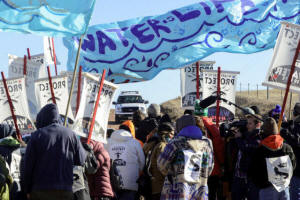|
Protesters arrested at North Dakota
pipeline as decision expected
 Send a link to a friend
Send a link to a friend
 [November 12, 2016]
By Stephanie Keith and Julia Harte [November 12, 2016]
By Stephanie Keith and Julia Harte
MANDAN, N.D./WASHINGTON (Reuters) - About
40 people involved in protests against the Dakota Access oil pipeline
were arrested on Friday in rural North Dakota as the U.S. Army Corps of
Engineers said it would soon clarify its plans for the controversial
project near sacred tribal lands.
Army Corps of Engineers spokeswoman Amy Gaskill said it would issue a
decision on its next steps within a few days, though it would perhaps
not be a final decision. And it was unclear if the agency's next action
would resolve the question of whether the line can be built as planned
under Lake Oahe, where construction ceased in September.
In North Dakota, police confronted about 100 protesters barricading a
highway adjacent to a construction easement for the pipeline, which has
drawn steady opposition from Native American and environmental activists
since the summer.
Within the pipeline easement itself, officers found construction
equipment vandalized, with wires cut, machinery spray-painted and
windows smashed, the Morton County Sheriff's Department reported.
A total of 37 arrests were made, most of them at a second illegal
roadblock nearby, sheriff's spokesman Rob Keller said. Private security
personnel reported activists hurled rocks at them, and one protester who
attacked an officer was pepper-sprayed, according to police.

A spokesperson for Energy Transfer Partners, which owns the pipeline,
confirmed two to three pieces of equipment were damaged, but the extent
was not known.
Smoke was seen billowing from a large excavation machine near a site off
Route 6 in rural North Dakota, and protesters had also climbed into
other equipment, according to a Reuters witness. Two workers were seen
leaving the scene.
Completion of the $3.7 billion Dakota Access Pipeline, set to run 1,172
miles (1,885 km) from North Dakota to Illinois, was delayed in September
so federal authorities could re-examine permits required by the Army
Corps of Engineers.
Plans called for the pipeline to pass under Lake Oahe, a federally owned
water source, and to skirt the Standing Rock Sioux Reservation by about
a half-mile (one km). Most of the construction has otherwise been
completed.
The Standing Rock tribe and environmental activists said the project
would threaten water supplies and sacred Native American sites and
ultimately contribute to climate change. Protests have at times turned
violent, as security dogs attacked activists during the summer and more
recently as protesters set fire to vehicles and equipment.
[to top of second column] |

Protesters lock arms during a standoff with a police car along the
pipeline route during a protest against the Dakota Access pipeline
near the Standing Rock Indian Reservation in St. Anthony, North
Dakota, U.S. November 11, 2016. REUTERS/Stephanie Keith

“The tribe continues to ask water protectors to remain peaceful and
prayerful," said Standing Rock Sioux spokeswoman Chelsea Hawkins on
Friday.
'NOTHING ... TO STOP'
The Obama administration requested a voluntary halt to construction
within 20 miles (32 km) of the lake on each side.
Energy Transfer Partners, which owns the line, continued to build to
the edge of the federal land where the lake is located.
The company earlier this week said it was "mobilizing" drilling
equipment to prepare to tunnel under the lake. That has angered
protesters, who planned more protests in coming days.
An ETP spokeswoman said, "Construction is actually complete in North
Dakota, except for the bore under the lake, so there is nothing for
them to stop."
Pipeline supporters say the project offers the fastest and most
direct route for bringing Bakken shale oil from North Dakota to U.S.
Gulf Coast refineries and would be safer than transporting the oil
by road or rail.
(Reporting by Stephanie Keith in Mandan, North Dakota; additional
reporting by Liz Hampton in Houston and Steve Gorman in Los Angeles;
Editing by Chizu Nomiyama and Cynthia Osterman)
[© 2016 Thomson Reuters. All rights
reserved.]
Copyright 2016 Reuters. All rights reserved. This material may not be published,
broadcast, rewritten or redistributed.
 |